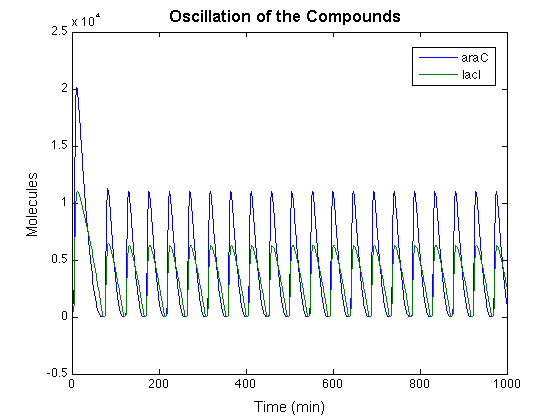Team:Todai-Tokyo/Modeling
From 2009.igem.org
| Line 110: | Line 110: | ||
From the graph we could see the oscillation pattern stabilized after the first peek. And the period of oscillation is around 50 min. Since this is the result of a deterministic method, it is no surprise that the peeks are perfectly identical. From the result we get, it is safe to predict that the actual system should exhibit the oscillation pattern similar to the graph above with some possible noise and unstable behavior. | From the graph we could see the oscillation pattern stabilized after the first peek. And the period of oscillation is around 50 min. Since this is the result of a deterministic method, it is no surprise that the peeks are perfectly identical. From the result we get, it is safe to predict that the actual system should exhibit the oscillation pattern similar to the graph above with some possible noise and unstable behavior. | ||
| + | |||
| + | =='''Lambda Phage Switch'''== | ||
| + | What differentiate our bioclock from other similar system is we make it controllable from the outside world. The lambda pahge switch is a complex bio-system on its own, by twisting the circuit a little, adding a lacI coding site in detail, enables us to adapt the switch into the system, to get an integrated system which is exactly what iGEM is all about. In this section we will model the switching device and study its properties in depth. | ||
| + | |||
| + | ===Construction of the Model=== | ||
| + | |||
| + | The Lambda Phage switch forms the circuit by having double-stranded DNA. We borrowed a figure from [2] to show the complete structure of the switch. | ||
| + | |||
| + | [[Image: Lambda_switch_structure.tiff]] | ||
| + | |||
| + | From this figure we learnt that there are several independent promotor sites on the DNA that direction of transcription is not united. At the initial state, the system is filled with exceeding amount of cI. Therefore, promotors are repressive and the "Lambda switch" is turned off. When the system is exposed to UV light cI begin to disintegrate, as a result, the Lambda switch promotors are "turned on", and cro expression begin. This will facilitate the transcription on PL that makes N expresses. N has a NUT side upstream, which will quicken the transcription when N is bound, hence it forms a self-activate structure which could rapidly produces N. It will then help the expression of cII and cIII that finally turns on the <math>P_{RE}</math> promotor and begin making cI. The system will eventually get exceeding amount of cI again, which should effectively "turn off" the switch by itself, going back to the initial state. In our system, we add an lacI site after TL1 therefore, it could be interact with the bio-oscillator discussed above. In all, we want to take advantage of the time delay between the process, therefore making the oscillation both controllable from outside and will stop according to its inside condition. | ||
| + | |||
| + | ===Modeling and Result=== | ||
| + | |||
| + | According to [2] and [3], after our simplification, the reactions of the system can be concluded as the following: | ||
| + | |||
| + | |||
=='''Reference'''== | =='''Reference'''== | ||
Revision as of 12:09, 21 October 2009
| Home | The Team | The Project | Parts Submitted to the Registry | Modeling | Notebook | Protocols | Ethics |
|---|
Contents |
Overview
As we described in the project overview of the bioclock project, the actual clock consists of two separable parts: a bio-oscillator and a lambda phage switch. In the section we will be modeling each of the parts and come up with an integrated model, which resembles the ultimate goal of the project. By making comparisons of the result of our model and the result of the original article which we based our simulation upon, we will be trying to examine how realistic is the model, and gain better understanding of how the oscillation process and, eventually, the integrated model are working.
Bio-Oscillator
Construction of the Model
In the natural world, there are quite a few system were known to act as an oscillator. The project started out by examining the behavior of Cyanobacteria. We learnt that the mutual activation and repression between several compounds resulted in the oscillation pattern of protein expression. We finally settled on creating a system utilizing lacI and araC as the mutual-interaction compound to construct a oscillator.
Although it is possible to trace the reactions in detail all the way from the transcription of mRNA and translation of the proteins, with the precise reaction rate, it will be redundant to do so. In order to maintain clarity, we simplify this process to focus only on the rate of translation. One of the defining characteristics is the duel role of the promotor. It could be bound with maximum of two lacI protien and one araC protien. When a araC is bound on it, it activates the translation of both araC and lacI, increasing lacI concentration while enhancing the possibility of lacI binding to the promotor as well. When promotor is bound with to lacI, it could transmute in to a looped form, in which araC is forbidden to bind. We will note the state of promotor as <math>P^{a/r}_{i,j}</math>, where i is representing the number of araC bound, while j represents that of lacI's.
According to [1], the reaction involved in the dynamics of the promotor state changes and reaction could be summarized as following: <math>P^{a/r}_{0,j} + a_{2} \xrightleftharpoons [k_{-a}]{k_{a}} P^{a/r}_{1,j}</math>
<math>P^{a/r}_{0,j} + a_{2} \xrightleftharpoons [k_{-a}]{k_{a}} P^{a/r}_{1,j}</math> <math>P^{a/r}_{i,0} + r_{4} \xrightleftharpoons [k_{-r}]{2k_{r}}P^{a/r}_{i,1}</math> <math>P^{a/r}_{i,1} + r_{4} \xrightleftharpoons [2k_{-r}]{k_{r}} P^{a/r}_{i,2}</math> <math>P^{a/r}_{1,2} \xrightarrow {k_{l}} P^{a/r}_{L,2} + a_{2}</math> <math>P^{a/r}_{0,2} \xrightarrow {k_{l}} P^{a/r}_{L,2} </math> <math>P^{a/r}_{L,2} \xrightarrow {k_{ul}} P^{a/r}_{0,0} </math> <math>P^{a/r}_{0,0} \xrightarrow {b_{a/r}} P^{a/r}_{0,0} + m_{a/r}</math> <math>P^{a/r}_{1,0} \xrightarrow {\alpha b_{a/r}} P^{a/r}_{1,0} + m_{a/r}</math>
<math>m_{a} \xrightarrow {t_{a}} m_{a} + a_{uf}</math> <math>m_{r} \xrightarrow {t_{a}} m_{r} + r_{uf}</math> <math>a_{uf} \xrightarrow {k_{fa}} a</math> <math>r_{uf} \xrightarrow {k_{fr}} r</math> <math>a+a \xrightleftharpoons[k_{-da}]{k_{da}} + a_{2}</math> <math>r+r \xrightleftharpoons[k_{-dr}]{k_{dr}} + r_{2}</math> <math>r_{2}+r_{2} \xrightleftharpoons[k_{-t}]{k_{t}} + r_{4}</math> <math>m_{a/r} \xrightarrow {d_{a/r}} \empty</math> <math>a_{uf} \xrightarrow {\lambda f(X)}} \empty</math> <math>r_{uf} \xrightarrow {f(X)} \empty</math> <math>a \xrightarrow {\lambda f(X)}} \empty</math> <math>r \xrightarrow {f(X)}} \empty</math> <math>a_{2} \xrightarrow {\lambda f(X)}} \empty</math> <math>r_{2} \xrightarrow {f(X)} \empty </math>
<math>P^{a/r}_{1,j} \xrightarrow {f(X)} P^{a/r}_{0,j} </math> <math>P^{a/r}_{i,1} \xrightarrow {f(X)} P^{a/r}_{i,0} </math> <math>P^{a/r}_{i,2} \xrightarrow {2f(X)} P^{a/r}_{i,1} </math> <math>P^{a/r}_{L,2} \xrightarrow {2\epsilon f(X)} P^{a/r}_{L,1} </math> <math>P^{a/r}_{L,1} \xrightarrow {\epsilon f(X)} P^{a/r}_{L,0} </math>
where
<math>f(X) = \frac{\gamma}{c_{e}+X} </math>
and X is the total number of ssrA tags in the system. k_{a}(It is a tag in order to quicken the disintegration process of the proteins.) The parameters of above reaction is listed as below: <math>b_{a} = b_{r} = 0.36 min^{-1}, \alpha = 20, k_{a} = 0.533 min^{-1}, k_{r} = 0.0181min^{-1}, k_{-a} = k_{-r} = 1.8 min^{-1}, t_{a} = t_{r} = 90min^{-1}, d_{a} = d_{r} = 0.54 min^{-1}, k_{fa} = k_{fr} = 0.9 min^{-1} , k_{da} = k_{dr} = k_{t} = 0.018 min^{-1} molecules^{-1}, k_{−da} = k_{−dr} = k_{−t} = 0.00018 min^{-1}, k_{l} = 36 min^{−1} , k_{ul} = 0.18 min^{−1}, \gamma = 1080molecules/min, c= 0.1 molecules, \lambda = 2.5, and \epsilon = 0.2 </math>
Modeling and the Result
We set the initial state of the system to have only 75 <math>P^{a/r}_{0,0}</math> and every other compound is set to zero. We used the SimBiology toolbox in the MATLAB for the simulation, and the result is shown as the graph below.
From the graph we could see the oscillation pattern stabilized after the first peek. And the period of oscillation is around 50 min. Since this is the result of a deterministic method, it is no surprise that the peeks are perfectly identical. From the result we get, it is safe to predict that the actual system should exhibit the oscillation pattern similar to the graph above with some possible noise and unstable behavior.
Lambda Phage Switch
What differentiate our bioclock from other similar system is we make it controllable from the outside world. The lambda pahge switch is a complex bio-system on its own, by twisting the circuit a little, adding a lacI coding site in detail, enables us to adapt the switch into the system, to get an integrated system which is exactly what iGEM is all about. In this section we will model the switching device and study its properties in depth.
Construction of the Model
The Lambda Phage switch forms the circuit by having double-stranded DNA. We borrowed a figure from [2] to show the complete structure of the switch.
File:Lambda switch structure.tiff
From this figure we learnt that there are several independent promotor sites on the DNA that direction of transcription is not united. At the initial state, the system is filled with exceeding amount of cI. Therefore, promotors are repressive and the "Lambda switch" is turned off. When the system is exposed to UV light cI begin to disintegrate, as a result, the Lambda switch promotors are "turned on", and cro expression begin. This will facilitate the transcription on PL that makes N expresses. N has a NUT side upstream, which will quicken the transcription when N is bound, hence it forms a self-activate structure which could rapidly produces N. It will then help the expression of cII and cIII that finally turns on the <math>P_{RE}</math> promotor and begin making cI. The system will eventually get exceeding amount of cI again, which should effectively "turn off" the switch by itself, going back to the initial state. In our system, we add an lacI site after TL1 therefore, it could be interact with the bio-oscillator discussed above. In all, we want to take advantage of the time delay between the process, therefore making the oscillation both controllable from outside and will stop according to its inside condition.
Modeling and Result
According to [2] and [3], after our simplification, the reactions of the system can be concluded as the following:
Reference
[1] Jesse Stricker, Scott Cookson, Matthew R. Bennett, William H. Mather, Lev S. Tsimring and Jeff Hasty, 2008 A fast, robust and tunable synthetic gene oscillator ( and Supplementary Information) Nature 07389 Vol 456: 516-519
[2] Adam Arkin, John Ross and Harley H. McAdams, 1998 Stochastic Kinetic Analysis of Developmental Pathway Bifurcation in Phage lambda-Infected Escherichia coli Cells Genetics 149: 1633–1648
[3] Shea, M. A., and G. K. Ackers, 1985 The OR control system of bacteriophage lambda: a physical-chemical model for gene regulation J. Mol. Biol. 181: 211–230
 "
"

